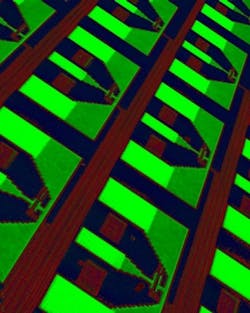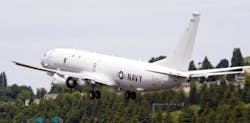Military optical computing uses fast optical interconnects for small size, light weight, and RFI immunity
By Courtney HowardTechnology focus -- The requirement for compact, lightweight, low-power electronics -- exacerbated by the growing demand for greater data throughput and bandwidth -- is driving the use of optical computing in military and aerospace applications. Optical components and systems are increasingly being investigated, as well as adopted, for a wealth of military optical computing applications for land, sea, air, and space.“Customers are definitely requesting more optical solutions in the mil-aero realm, and the interest is typically driven by one of more of optics’ advantages over copper,” explains Gregory Powers, market development manager at TE Connectivity Ltd. in Seattle (Tyco Electronics was renamed TE Connectivity Ltd. last month). “There are several benefits to optical computing, including: reduction of size, weight, and power (SWaP); electromagnetic interference (EMI) immunity; the fact that fiber optics offers a secure communication line where any tapping can be detected; ease of installation; and data rate over distance.“Some of these advantages are interdependent,” Powers adds. “For instance, because optical fiber is immune to EMI, there is no need for shielding of the cables. Shielding is heavy, adds size, and brings about a lot of installation and application problems. In composite aircraft, special provisions have to be made for bonding of the shields to assigned grounds and protection of shielding relative to lightning strike. Optical computing can minimize all these issues.”
Optical advantages
Optical components and systems are attractive for airborne applications, ranging from a flight-critical databus to a video or sensor link, given the desire for the reduction of SWaP, ease of installation, and EMI immunity, Powers says. In ground-based applications -- such as secure bunker-to-bunker communications, electro-optic (EO) sensor mast-to-control station links, or RF over fiber antennae links -- the advantage of optics over distance often is the deciding factor, followed by EMI immunity, security, and reduced weight. “The big thing we’re seeing is in a lot of aircraft, they want to reduce weight,” observes Kirk Lussier, program and account manager at DiCon Fiberoptics in Richmond, Calif. “Fiber weighs a lot less [than copper] -- that’s a big advantage of moving to fiber-optic systems.
A lot of weight advantages exist, given glass fiber weighs less than copper, agrees Robert Schleicher, vice president of product development at DiCon Fiberoptics. “In telecom, fiber started at the longest networks, where it proved itself quickly from a cost perspective. Over the years, it has spread out and infiltrated smaller and smaller networks -- regional and then local networks, even within an office network -- and to some extent, the same trend is now extending itself to the networks within planes, ships, and land vehicles.”
Farther and faster
Optical components hold the potential for higher performance, an attractive attribute given the amount of data being acquired and exchanged on the digital battlefield. “Optical interconnects allow faster data transmission and, thus, higher processing speeds,” admits Andreas Gerster, worldwide business development manager of optics at Agilent Technologies Inc. in Santa Clara, Calif.
“As transceivers on aircraft become faster and faster, for example, they want more and more data bits,” Lussier notes. “It’s not a problem for optical technology. Our switches are all-optical; there’s no OEO (optical-electrical-optical) conversion, so it can handle any data rate.”
Optical technologies provide the ability to transport high volumes of data over significant distances. Copper backplanes and cable assemblies, as have been deployed throughout mil-aero environments, are extremely length sensitive. “The greater the distance, the higher the attenuation and the lower the data rate,” Powers explains. “Optical fiber has much, much lower attenuation, thereby eliminating distance as a primary design constraint. Computers that need to communicate can be hundreds of meters apart and interact as though they are in the same chassis.”
“The transmission speeds in electronics have now reached 10G (10 gigabits) and more per I/O (input/output) pin, which drives all kinds of digital interconnects based on copper to the limit,” Gerster says. “This makes optical computing technologies much more attractive for applications in the aerospace and defense sector.”
Rugged embedded computing systems need to have high data rate input/output, for which fiber optics are ideal, Powers mentions. “The I/O could be a relatively short link, connecting two plug-in modules in the same chassis, or could be a longer run, say from a shipboard sensor mast to a processor and data storage bank. There are numerous data intensive applications where the advantages of optical computing pay dividends, including radar installations, EO sensor suites, persistent wide area surveillance, signals intelligence, and more.”
Design distinction
“Most processing is done in an electronic chip -- an ASIC, a semiconductor -- and, at some point, you convert to light,” Powers explains. After this electro-optic conversion, “the light can be sent through circuit boards in a waveguide, which is typically outside of the circuit board in today’s applications. As soon as the light is introduced to a fiber, you can route that fiber anywhere. You can take that very fast data stream and run it from a daughter module through the backplane to an I/O connector, and then it could stay inside the chassis or be sent a kilometer away. The computers really know no difference.
“That whole concept is quite powerful,” Powers continues. “What fiber optics enable is not distance-sensitive, like copper is. If someone is designing a large platform -- a 747 or C5 aircraft or a military base perimeter system -- they can have these cards virtually anywhere they need them. Let’s say it was going in an aircraft, you could put these boxes where it made sense in the aircraft for weight distribution or heat or protection issues; with copper, you need to co-locate the items because of length sensitivity. That’s one of the powerful aspects of fiber optics: location-independent architecture. It frees the designer of distance constraints.”
Safe and secure
Higher security is, likewise, a big advantage in mil-aero applications. Optics, by nature, are “immune to electronic countermeasures and reconnaissance, as there are no electromagnetic emissions,” Gerster adds.
Optical computing, networking, and communications avoid TEMPEST (Transient Electromagnetic Pulse Standard) issues, lending to increased security. TEMPEST is “emissions from copper cables carrying signals that could be sniffed or detected in some way,” Schleicher describes.
“When the information is in a fiber, there’s no electromagnetic radiation by which the information can get out and get sniffed by someone you don’t want to sniff it. You have to get to the fiber physically to get the information,” Lussier explains.
“The barrage of testing that a lot of defense applications will demand of a product, if it has data communications over copper wire, is referred to as TEMPEST testing. That’s a big concern,” Schleicher continues. “You want to make sure the information doesn’t get to the wrong people -- that’s another big advantage to fiber optics.”
Optical technology plays a role in physical, as well as digital, security. Fiber-optic intrusion detection technology from Future Fibre Technologies (FFT) in Mountain View, Calif., physically protects highly sensitive communication and data networks at an unnamed U.S. military facility.
The installation, using the FFT Secure Link system as an “alarmed carrier” Protective Distribution System (PDS), protects Secret Internet Protocol Router Network (SIPRNet) data links between facilities against illegal interference, data tapping, and unauthorized physical disturbance. SIPRNet is a system of high-security, interconnected computer networks used by the U.S. Department of Defense (DOD) and the U.S. Department of State to transmit classified information.
“The FFT solution is perfect for military networks that require real-time notification of intrusion attempts,” says Emmett McGrath, Secure(it) program manager for Communications Supply Corporation, a subsidiary of WESCO Inc., in Carol Stream, Ill. “Secure Link is a cost-effective alternative to conducting periodic visual inspections and provides real-time notification of the precise location of intrusion attempts.”
Industry investment
The benefits of optical technologies are many, and organizations are working diligently to deliver capable fiber-optic components, systems, standards, and information to the mil-aero community for myriad applications.
Calumet Electronics Corp. officials have deployed a new optical interconnect research lab at the company’s production facility in Calumet, Mich. “Electronic operating systems have had a steadily increasing need for higher digital data-transfer rates within on-board components, circuit boards, and backplanes,” a spokesperson says. Current state-of-the-art interconnect systems use “metal interconnects with limited data-transmission capacity. Latencies associated with the speed at which the data can be transferred impose a limit on the overall system performance.”
Calumet is working with Michigan Technological University of Houghton, Mich.; Dow Corning Corp. of Midland, Mich.; and Lockheed Martin of Bethesda, Md., in a joint research-and-development program funded by the Department of Defense to develop manufacturing capability to produce circuit boards with optical interconnections that provide data processing solutions.
“The deployment of this facility will allow us to mature optical interconnect materials and manufacturing processes that will take this critical technology from our lab to our production floor,” states Stephen Marshall, national sales manager at Calumet. He anticipates the company will provide a “‘Made in the USA’ solution for this quantum shift in interconnection technology.”
TE Connectivity, too, specializes in connectivity, including electrical, optic, and electro-optic conversion. “These technologies are all fundamental within optical computing,” mentions Powers, who is a member of the VITA 66 Working Group within the VITA Standards Organization in Fountain Hills, Ariz. The VITA 66, Fiber Optic Interconnect draft specifications are in a mature state, following more than two years of work, and are likely to be completed and ratified this year. “The sooner the better,” he says.
“VITA 66, which is the optic connectors, and Vita 67, which are RF connectors, are moving forward rapidly as draft specifications. They will round out the VPX (VITA 46) ecosystem; you’ll have high-speed digital connectors and also a choice of RF and optic modules that are compatible,” Powers adds. “VITA 66 will be quite revolutionary.”
VITA is listed as a hosting organization to the new OpComp technical forum, designed to bring together academia, research and development, and application developers to discuss optical computing technologies for critical embedded computing systems. The inaugural OpComp is scheduled to take place September 26-27, 2011 in San Jose.
P-8A Poseidon
“When DiCon Fiberoptics was founded in 1986, we were making optical switches for the U.S. Navy,” Lussier says, noting increased interest from defense programs as time goes on. “We are gaining interest from virtually any type of military craft -- aircraft, land vehicles, and naval ships.”
The DiCon Fiberoptics Secure Switching Unit (SSU) -- an optical switching device that enables secure fiber-optic signals to be routed by the company’s MEMS (microelectromechanical systems) optical switches -- was used in the first mission systems test flight of Boeing’s P-8A Poseidon aircraft. U.S. Navy officials plan to replace the existing P-3C fleet with P-8A Poseidon anti-submarine, anti-surface warfare, intelligence, surveillance, and reconnaissance aircraft.
“We have taken our proven COTS (commercial off-the-shelf) fiber-optic switch components and integrated these into the SSU to offer Boeing a reliable way to route secure fiber-optic signals in the P-8A,” Schleicher explains. The mil-spec, common criteria-certified, all-optical SSU delivers compact size, low weight, low power consumption, the ability to withstand harsh environments, and a frictionless design that enables operation for billions of switch cycles.
In a FOG
Fiber-optic gyros (FOGs), which span the performance range from tactical to strategic applications in mil-aero, are at the forefront of optical fiber technology, says Jay Napoli, vice president of FOG & OEM sales at KVH Industries Inc. in Middletown, R.I. “FOG technology is unchallenged in terms of performance in demanding environments, including high rotational rate dynamics, wide operating temperature, and high vibration. As FOG technology has advanced, demand has increased and prices continue to decrease as the market benefits from ever-improving economies of scale.”
The KVH Industries high-performance, FOGs are employed in the Javelin Basic Skills Trainer (BST), used by the U.S. Army to train soldiers to operate the Javelin anti-tank missile system. KVH’s FOGs precisely measure the shoulder-fired BST’s movement, and the system’s computer synchronizes that movement with the digital imagery scenario shown on the simulator’s viewfinder.
“In the Javelin BST, KVH’s solid-state, all-fiber FOGs measure angular rotation precisely and then deliver high-speed data to the simulator’s computer, enabling the BST to provide the trainee with a very realistic and accurate user experience,” Napoli describes. Precision FOGs are well suited to an expanding number of optical and image stabilization applications, including mobile mapping, dynamic surveying, gimbaled cameras, autonomous vehicles, and underwater remote-controlled vehicles.
UAV FOG
Israel-based Rafael Advanced Defense Systems has adopted KVH’s dual-axis DSP-4000 FOGs for integration within its Remote Weapon Station (RWS), which provides critical optical and weapon stabilization capabilities to increase RWS accuracy and effectiveness. “Remote weapon stations like those produced by Rafael are playing an increasingly critical role on the battlefield, enabling soldiers to acquire and fire upon targets while remaining protected from hostile fire within the armored hull of the vehicle,” Napoli says.
KVH’s militarized DSP-4000 FOG is a high-performance, all-fiber gyro that ensures high reliability, superior performance, and exceptional vibration, shock, and acceleration survivability. The enhanced dual-axis DSP-4000 provided to Rafael features low noise, high bandwidth, high resolution, and stabilization and tracking capabilities for turret, antenna, optical, and weapon stabilization systems.
The Tamam Navigation FOG (TNF), from Israel Aerospace Industries (IAI) with an office in Arlington, Va., is a lightweight, airborne navigation and attitude heading reference system (AHRS) for use in unmanned aerial vehicles (UAVs), target drones, small aircraft, and helicopters, as well as for accurate targeting applications in stabilized electro-optical/infrared (EO/IR) systems. The system combines an FOG-based inertial measurement unit (IMU) from the Tamam Division of IAI’s Systems Missiles and Space Group and a GPS receiver.
Testing is an all-important aspect of the use of optical components and systems in mil-aero environments. In the absence of a test system and protocol, “an operator would be disconnecting and reconnecting a fiber every time they want to test a different line,” Lussier explains. “Every time you disconnect and reconnect, you put the connector at risk. You really have to be careful and clean it. If somehow you get a piece of dust on it and reconnect it without being aware that it’s there, you can introduce a lot of problems in the information flow. It won’t get through correctly.” DiCon Fiberoptics’ test systems, used by defense contractors, automate the process via software.
Agilent Technologies also provides a portfolio of test and measurement instruments and systems for the design and manufacturing of components for optical computing. “Through Agilent’s expertise in military and aerospace electronic test, we provide our customers with greater assurance in system readiness, enabling them to focus on fulfilling today´s mission and managing the transition to what comes next,” Gerster says. Agilent officials helped to establish a new chip-scale, micro- and nanophotonic-systems testing facility on the University of California, San Diego (UCSD) campus. The new facility is part of the National Science Foundation (NSF) Major Research Instrumentation (MRI) project, and is set up in conjunction with the multi-university Center for Integrated Access Networks (CIAN), led by The University of Arizona. The facility supports testing and characterization of micro- and nano-scale, ultra-high-speed optical components and subsystems.
Fiber’s future
Optical technologies and components are likely to enjoy a bright future in mil-aero applications. Technology firms intend to bring rapid optical advancements to myriad applications in aerospace and defense environments.
“Over time, I expect to see more and more appearances of some form of wavelength-division multiplexing (WDM) to get more bandwidth out of the fiber infrastructure,” Schleicher predicts. “It has been prevalent for years in telecom, which is now migrating from fixed DWDM (dense wavelength-division multiplexing) configurations to ones that are totally reconfigurable in real time. In mil-aero, perhaps the next step is some form of DWDM, and then reconfigurable optical networks over time, as well.”
The abilities to tailor an infrastructure to changing data patterns and traffic patterns, to perform the everyday tasks of adding and removing service installations, and to reconfigure a network on the fly certainly hold promise for mil-aero applications.
Company list
AboveNet Communications Inc.
www.above.net
U.S. Air Force Research Laboratory (AFRL)
www.afrl.af.mil
Agilent Fiber Optic Products Division
www.agilent.com
Alcatel-Lucent
www.alcatel-lucent.com
Amphenol Backplane Systems
www.amphenol-aerospace.com
Curtiss-Wright Controls Embedded Computing
www.cwcembedded.com
U.S. Defense Advanced Research Projects Agency (DARPA)
www.darpa.mil
DiCon Fiberoptics Inc.
www.diconfiberoptics.com
Enablence
www.enablence.com
Extreme Engineering Solutions (X-ES)
www.x-es.com
IBM
www.ibm.com
Intel Corp.
www.intel.com
ITT Interconnect Solutions
www.ittcannon.com
KVH Industries Inc.
www.kvh.com
Lightwave Logic
www.lightwavelogic.com
Mercury Computer Systems
www.mc.com
Massachusetts Institute of Technology (MIT)
web.mit.edu
Molex
www.molex.com
National Science Foundation (NSF)
www.nsf.gov
NASA
www.nasa.gov
Optical Interconnect
www.opticalinterconnect.com
Oracle
www.oracle.com
Peregrine Semiconductor
www.peregrine-semi.com
QinetiQ
www.qinetiq.com
RadiSys
www.radisys.com
Timbercon
www.timbercon.com
TE Connectivity
www.tycoelectronics.com
VITA
www.vita.com



